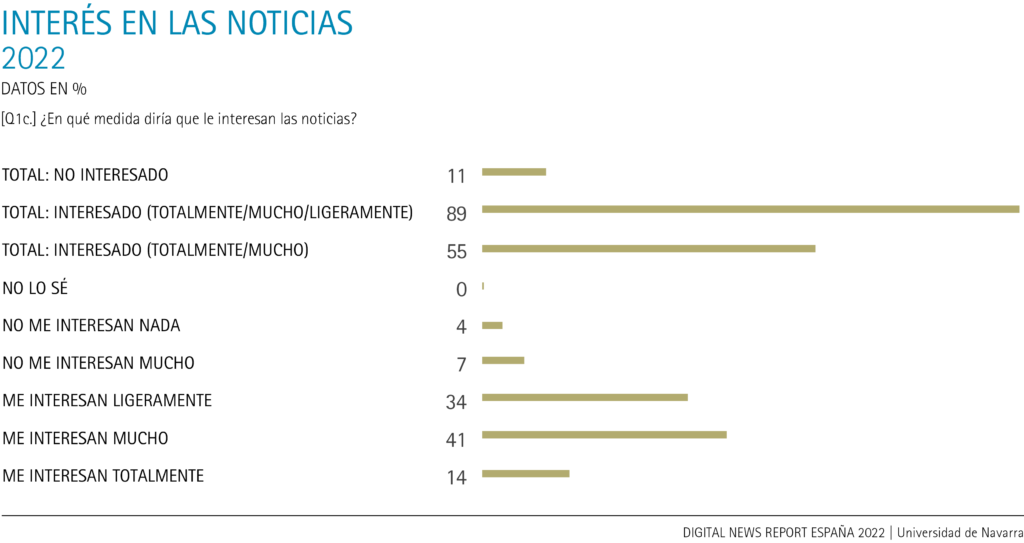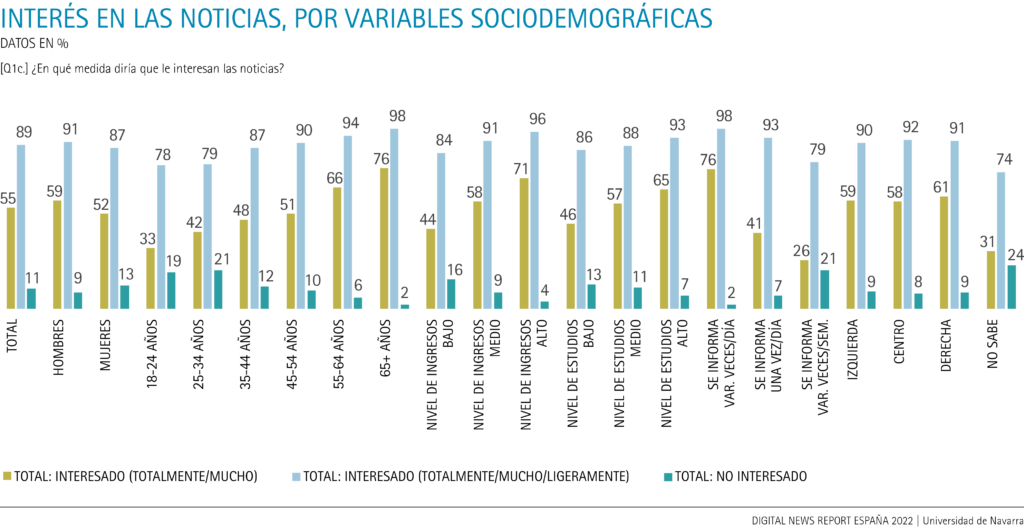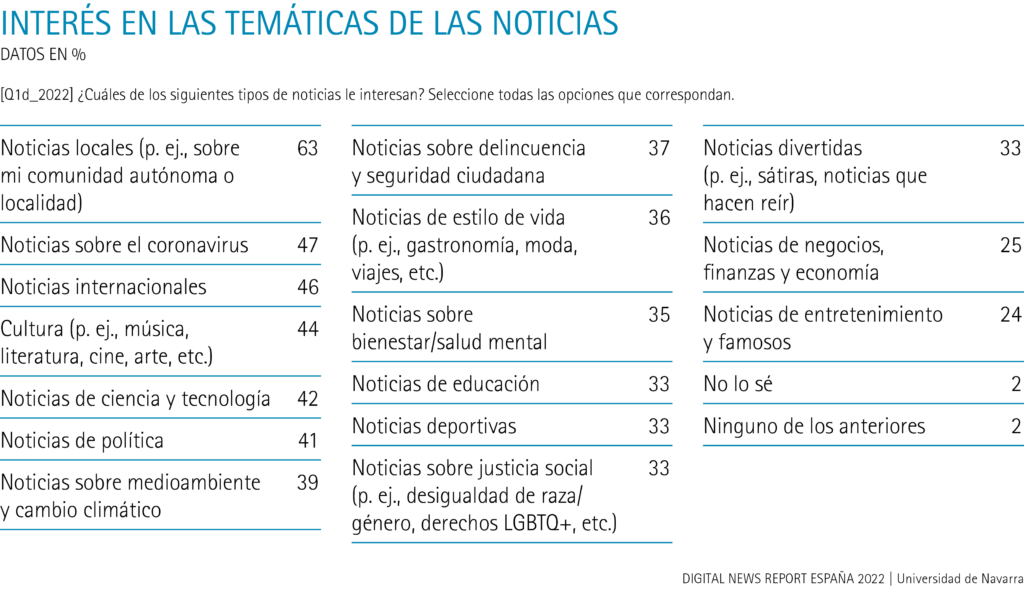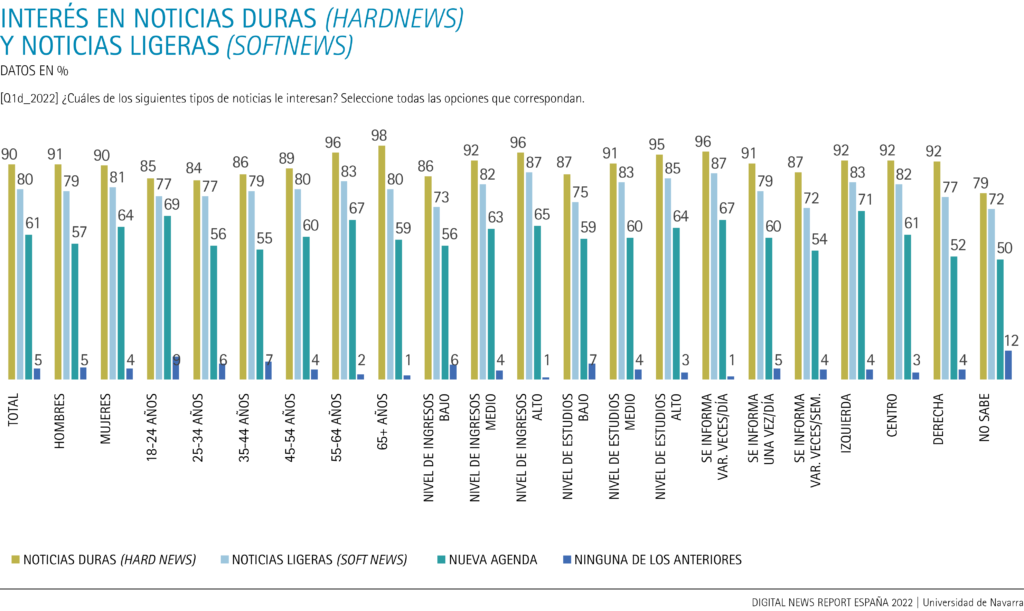-
Local news (e.g., about my autonomous community or locality) is of interest to six out of ten Internet users (63%) and is the preferred topic.
-
Users with high income (96%), high level educational (95%) and political affinity preferhard news such as local, political, international and coronavirus.
Although they are not synonymous, citizens' interest in news and their trust in it are two values that are somehow intertwined. On the one hand, interest is the public's positive inclination to understand their immediate and less immediate environment; it connects them with their social, political and cultural time, and financial aid them to decide and cope with uncertainty. On the other hand, trust is the firm hope that financial aid to satisfy an interest. In the case of information and news, it is a crucial value. For this reason, the data of the Digital News Report Spain 2022 is also worrying. In addition to the increase in distrust of news, there is also a lack of citizen interest in them. In the last eight years, the percentage of Spaniards very interested ('totally/much') in information has fallen from 85% in 2015 to 55% in 2022. Likewise, the percentage of those disinterested in the news has increased tenfold over this period of time: from 1% to 11%. As the previous chapter reflects, for people who lack interest in the news (due to weariness, fatigue, emotional reasons, etc.), their reliance on it is irrelevant. Conversely, those who do not trust the news tend to become disinterested in it. In this way, citizens can enter a vicious spiral of distrust and disinterest in the news.

However, and when looking at Degree for a broader interest in the news, it can be seen that almost nine out of ten Spanish Internet users are 'totally/much/slightly' interested (89%). The 45+ age group continues to be the one that sample is most interested in current affairs (94%); specifically, almost all adults over 65 years of age (98%). As already mentioned, only half of the users are 'totally/very much' interested (55%). In this regard, news appeals mainly to adults aged 45 and over: six out of ten (64%); and, in particular, seven out of ten of those over 65 (76%). The challenge of engaging young people remains. It is relevant that almost two out of ten young people aged 18 to 24 (19%), as well as two out of ten young adults aged 25 to 34 (21%), say they are not currently interested, compared to one out of ten respondents in general (11%).

By gender, men are more inclined to be interested in information. Nine out of ten of them declare a total, strong or slight interest (91%). This is 4 percentage points more when compared to women. Similarly, almost six out of ten men are 'totally/much' interested in the news (59%). This is 7 percentage points more compared to women. Hence, one in ten women say they are not interested in current affairs (13%), which is 4 percentage points more than men.
Combining age range and gender, almost all adult men aged 45-54 (95%) and adult men aged 55-64 (95%) are characterized as being 'totally/much/slightly' interested in the news. In particular, those over the age of 65 (98%). In contrast, young adult women aged 25-34 (25%) and men under 35 (18%) are the age and gender groups least attracted to current affairs.
There is also a positive relationship between respondents' income and their reported interest in news. Almost all high-income Internet users are 'totally/much/slightly' interested in the news (96%). This is 5 percentage points more when compared to those with an income average and 12 points more than those with an income leave. This association is more significant when evaluating users who are 'totally/much' interested and have a high income (71%). Thus, grade shows a difference of 27 percentage points compared to those with an income of leave and 13 points compared to those with an income of average. Logically, Internet users with an income of leave are less attracted to current affairs (16%). They differ by 12 points at reference letter from those with a high income.
There is also a positive correspondence between the level of educational of the respondents and their interest in news. Thus, nine out of ten Internet users with a high educational level show a total, strong or slight interest in the news (93%). This is eight out of ten in the case of people with a low (86%) or medium (88%) educational level. The percentage difference widens among users who are 'totally/much' interested. Six out of ten people at educational high (65%) and almost six out of ten at educational medium (57%) say this compared to four out of ten at educational low (46%). Topicality does not matter to one in ten of those at low educational (13%).
Similarly, the more defined the political leanings of the public, the greater their interest in the news. There are no significant variations among respondents who are on the right (91%), left (90%) or center (92%) and who show a total, strong or slight interest in the news. However, fewer are those who do not define themselves politically and have this Degree interest (74%). Therefore, this behavior is seen among 'totally/much' interested Internet users. Three out of ten people who do not know where they stand politically show this level of interest in the news (31%) compared to six out of ten of those who position themselves on the right (61%), and almost six out of ten of those who are on the left (59%) or in the center (58%). Hence, two out of ten respondents who do not know how to define themselves politically are not interested (24%). This amounts to 13 percentage points on the average.
Finally, there is a certain positive link between the respondents' Degree interest in current affairs and the frequency of access to news. Almost all of the 'totally/much/slightly' interested Internet users consult the news several times a day (98%) or once a day (93%). Specifically, seven in ten of those 'totally/mostly' interested turn to the news several times a day (76%). That's 21 percentage points above the average of this level of interest.

Favorite news items: local, coronavirus and international
Proximity information continues to have a good evaluation among Spanish Internet users. Six out of ten respondents are interested in local news (e.g., about my autonomous community or locality) (63%), which is the preferred topic. Other important subjects that attract four out of ten Internet users are news about coronaviruses (47%), international news (46%), culture (e.g., music, books, cinema, art, etc.) (44%), science and technology (42%), and politics (41%). Less popular are environment and climate change (39%), crime and public safety (37%), lifestyle (e.g., food, fashion, travel, etc.) (36%), wellness/mental health (35%), sports (33%), Education (33%), social justice (e.g., race/gender inequality, LGBTQ+ rights, etc.) (33%), and funny news (e.g., satire, news that makes you laugh) (33%). Information about business, finance and Economics (25%), and entertainment and celebrity news interest only two in ten (24%).

It is the 45+ age group that is most interested in local information (e.g., about my autonomous community or locality): seven out of ten (73%). In particular, this topic attracts adults aged 55 to 64 (77%). The 45+ age group also prefers international news (56%), news about coronavirus (56%) and politics (52%). Specifically, international news (71%), politics (67%) and coronavirus news (62%) are accepted among adults 65+, who also care about sports (44%), and business, finance and Economics (32%). For their part, adults aged 55-64 care about science and technology (51%), environment and climate change (50%), culture (e.g., music, books, movies, art, etc.) (49%), crime and public safety (45%), wellness/mental health (44%), lifestyle (e.g., food, fashion, travel, etc.) (44%), Education (39%) and funny news (e.g., satire, news that makes you laugh) (36%). Finally, 18-24 year olds favor culture (e.g., music, books, movies, art, etc.) (52%), social justice (e.g., race/gender inequality, LGBTQ+ rights, etc.) (46%), and entertainment and celebrity news (32%).
At reference letter by gender, men prefer international news (51%, which is 10 percentage points more than women), science and technology (50%, which is 15 percentage points more), sports (49%, which is 31 percentage points more), politics (47%, which is 11 percentage points more) and information on business, finance and Economics (34%, which is 16 percentage points more). Women favor news about coronavirus (50%, which is 7 percentage points more than men), culture (e.g., music, books, movies, art, etc.) (48%, which is 8 percentage points more), lifestyle (e.g., gastronomy, fashion, travel, etc.) (48%, which is 8 percentage points more), dining, fashion, travel, etc.) (44%, which are 15 points higher), wellness/mental health (41%, which are 13 points higher), Education (38%, which are 10 points higher), and entertainment news and celebrities (32%, which are 16 points higher).
Combining age range and gender, adult men ages 55-64 care about news about science and technology (59%), and business, finance and Economics (46%). Men age 65 and older gravitate toward international news (82%), politics (74%), sports (59%), and social justice (e.g., race/gender inequality, LGBTQ+ rights, etc.) (41%). However, young adult women ages 25-34 favor funny news (e.g., skits, news that makes you laugh) (40%), and entertainment and celebrity news (38%). The Education appeals to adult women aged 45-54 (45%). The thematic repertoire is more diverse among women aged 55-64: local news (e.g., autonomous community or locality) (79%), coronavirus (65%), wellness/mental health (51%), culture (e.g., music, books, film, art, etc.) (53%), environment and climate change (52%), lifestyle (e.g., dining, fashion, travel, etc.) (50%), social justice (e.g., race/gender inequality, LGBTQ+ rights, etc.) (41%), and crime and public safety (46%).
When looking at the income level of the respondents, it can be seen that high-income Internet users are more inclined towards the so-called hard news (96%) compared to those with an income of leave (86%). Among this subject news, local (68%), political (61%), international (57%) or coronavirus (50%) stand out. The percentage difference is 13 points in the first case, 34 points in the second, 24 points in the third and 9 points in the fourth. High-income users also favor thematic diversity: science and technology (54%), culture (e.g., music, books, movies, art, etc.) (49%), environment and climate change (46%), sports (45%), business, finance and Economics (42%), crime and public safety (40%), wellness/mental health (38%), and social justice (e.g., race/gender inequality, LGBTQ+ rights, etc.) (37%).
Likewise, hard news is of greater interest to respondents with a high level of educational (95%) compared to those with a low level of educational (87%). In this case, it is also local news (e.g., autonomous community or locality) (67%), international (58%), political (53%) and coronavirus (50%). There is a percentage difference of 8 points in the first case, 25 points in the second, 22 points in the third and 6 points in the fourth. Users with a high level of training also opt for heterogeneous topics: culture (e.g., music, books, movies, art, etc.) (55%), science and technology (52%), environment and climate change (42%), Education (38%), business, finance and Economics (37%), and sports (34%).
In terms of political location, there is no significant distinction in the preference for hard news, although respondents on the left show a certain inclination towards soft news (83%). This is a percentage difference of 6 points compared to those on the right. Still, audiences on the left opt for local news (e.g., community or locality) (67%), culture (55%), environment and climate change (51%), coronavirus (51%), social justice (e.g., race/gender inequality, LGBTQ+ rights, etc.) (50%), wellness/mental health (38%), Education (36%) and funny news (e.g., satire, news that makes you laugh) (36%). On the other hand, the right-leaning audience prefers politics (51%), crime and public safety (41%), and business, finance and Economics (30%). The public that declares itself to be from the political center prefers international information (54%), science and technology (48%), and sports (38%) as well as news about crime and public safety (41%), funny news (e.g., satires, news that make people laugh) (36%), and business, finance and Economics (31%).

Finally, users interested in certain topics considered as hard news have a higher frequency of access to current affairs. These are those who prefer, for example, local (71%), international (58%), political (57%), coronavirus (54%), culture (50%), or science and technology (49%) information.